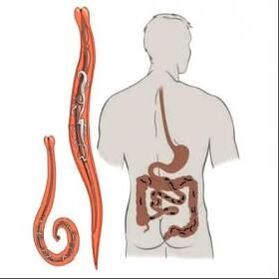Helminthiases are a group of diseases caused by parasitic worms. Helminths can be located in a person’s intestines, lungs, gallbladder and bile ducts. Parasites cause mechanical damage to internal organs, helminth waste products lead to intoxication. For humans, helminthiasis is also dangerous for the fact that it suppresses the immune system, worsens the course of other diseases, leads to increased fatigue, reduces the intestinal absorption capacity, reduces the effectiveness of vaccination, etc. You can become infected with helminths by drinking contaminated water or unwashed food. In rare cases, the disease is transmitted through the skin or air.
Helminths can be located in a person’s intestines, lungs, gallbladder and bile ducts. Parasites cause mechanical damage to internal organs, helminth waste products lead to intoxication. For humans, helminthiasis is also dangerous for the fact that it suppresses the immune system, worsens the course of other diseases, leads to increased fatigue, reduces the intestinal absorption capacity, reduces the effectiveness of vaccination, etc. You can become infected with helminths by drinking contaminated water or unwashed food. In rare cases, the disease is transmitted through the skin or air.
Classification of helminthiasis
By location:
- Intestine.These include ascariasis, strongyloidosis, trichocephalosis, teniarinchiasis, etc.
- Pulmonary.This group includes tominxosis and paragonimosis.
- Ind.This class includes schistosomiasis, trichinosis, toxocariasis, and filariasis.
- Hepotobiliary systems.This group includes opisthorchiasis, fascioliasis, and clonorchiasis.
According to the stage:
- Sharp.Helminthiasis usually appears 2-4 weeks after infection. Depending on the severity of the helminthic invasion, signs of helminthiasis are observed from 1 week to several months, then the disease becomes chronic.
- Chronicle.The clinical manifestations of chronic helminthiasis depend on the characteristics of the parasite species. In the presence of helminths with larval reproduction (filariasis or strongyloidosis), allergic manifestations persist for a long time. In other forms of the disease, the symptoms depend on the number, size and location of the parasites in the body.
Deficiencies of helminthiasis and trace elements
Once placed in the human body, the parasites feed on blood and tissue fluids, absorbing nutrients. For growth and reproduction, helminths, first of all, need trace elements, which leads to a decrease in their content in the body. The consequence of helminthiasis may be a lack of the following trace elements:
Lack of zinc.Causes prostate, infertility, dwarfism, parakeratosis (resembling scabies or scabies), various tumors and many other pathologies.
Selenium deficiency.Leads to a decrease in immunity, can provoke the development of malignant tumors of the gastrointestinal tract, mammary glands, prostate.
Iodine deficiency.Causes slow growth, impaired puberty and underdevelopment of reproductive organs. With iodine deficiency, mental retardation is possible, up to dementia.
Manganese deficiency.It can cause brittle bones, weight loss, seizures, dermatitis and genital tract degeneration.
Lack of chromium.Causes fatigue, sugar intolerance (borderline diabetes), growth retardation, increases cholesterol levels.
Signs of helminthiasis
- ethe;
- various skin rashes;
- swelling of the face, conjunctiva;
- inflammation of the upper respiratory tract;
- loose stools;
- in children, angina, lymphadenitis;
- bronchospasm, lung infiltrates, pneumonia;
- myocarditis;
- hepatitis;
- meningoencephalitis.
Symptoms (clinical picture) of helminthiasis
Acute helminthiasis.For this form of helminthic infection signs of general allergic reactions are characteristic: itchy skin, fever, swollen lymph nodes, muscle and joint pain. Acute helminthiasis often leads to the development of pulmonary syndrome, abdominal pain, and dyspeptic disorders. At the same time, the liver and spleen increase in size and symptoms from the central nervous system may appear.
signs of general allergic reactions are characteristic: itchy skin, fever, swollen lymph nodes, muscle and joint pain. Acute helminthiasis often leads to the development of pulmonary syndrome, abdominal pain, and dyspeptic disorders. At the same time, the liver and spleen increase in size and symptoms from the central nervous system may appear.
Chronic helminthiasis.In many forms of helminthiasis, the parasitism of some single individuals develops without any unpleasant symptoms. Characteristic signs of helminthiasis appear in the presence of large worms (tenioid, broad-leaved, etc. ). Symptoms depend on the type and location of the parasite. With intestinal helminthiasis, pain, dyspeptic and asthenoneurotic syndromes are observed. Ascariasis can cause pancreatitis, obstructive jaundice and intestinal blockage. Enterobiasis is characterized by itching in the anus at night. With clonorchiasis and opisthorchiasis, hepatitis, cholecystocholangitis and various lesions of the gastrointestinal tract may develop.
Helminthiasis and infectious diseases
Worm infections increase the risk of contracting infectious diseases. Helminths reduce immunity and weaken the body as a whole. Thus, parasites open free entry into body tissues for germs and viruses. Helminthiasis can be accompanied by the following infectious diseases.
Toxoplasmosis.It is an infectious disease that affects humans and animals. You can become infected with toxoplasmosis through contaminated blood transfusions, by eating foods made from thermally raw meat or fish, or by contacting the patient's stools. Toxoplasmosis is transmitted from mother to child during intrauterine development. Infection can cause fetal death or miscarriage. Among newborns infected with toxoplasmosis, there is a high risk of mortality.
Chlamydia.An infectious disease that occurs in rodents, cats and humans. May be associated with fever, rhinitis, conjunctivitis and pneumonia. Affects the visual organs, reproductive and respiratory systems. Chlamydia is transmitted by air droplets, contact and sex.
Toksokara.The disease is observed in humans, pets, rodents. Toxocar eggs remain valid for months in dry stools. You can get an infection through contact with animal hair or through the soil. The disease is associated with severe allergies and pathology of internal organs.
Diagnosis and therapy of helminthiasis
How to identify helminthiasis
Prevention of helminthiasis is largely in line with strict hygiene standards. It is unacceptable to drink raw water and eat poorly processed or unfamiliar foods (fish, meat). Early detection of people infected with parasites also plays an important role in prevention. Diagnosis of helminthiasis is performed by identifying the larvae and eggs of helminths. Most often they are localized in different parts of the gastrointestinal tract, so the most common method is stool analysis.
In some cases, standard methods for diagnosing helminthiasis are ineffective. For example, some parasites do not lay eggs for a long time, and therefore cannot be found in the feces. An innovative method allows you to identify the presence of helminths and assess the general condition of the body from the iris of the eye. The method is based on the fact that each organ has a projection on a certain segment of the "iris", where it transmits information about its condition through the centers of the internal organs of the brain. Such a diagnosis of helminthiasis allows you to detect parasites even in cases where the usual test for helminth eggs is negative.

How to get rid of helminthiasis
An effective, safe and proven tool to get rid of helminthic invasion and replenish the necessary micronutrients in the body is a complex of medicines for helminths, which improves health in several key areas at the same time:
- improve immunity;
- normalize metabolism;
- improve the enzymatic functions of the stomach, pancreas, intestines;
- remove signs of allergies;
- normalize the activity of the gastrointestinal tract, etc.
Antiparasitic Wellness Program
To eliminate helminthiasis, it is necessary to take broad-spectrum antiparasitic drugs for 3 months. Between each month of admission, it is necessary to take a break of 7 days.






































